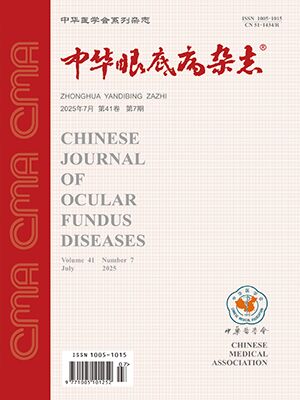| 1. |
Qin Y, Zhang J, Babapoor-Farrokhran S, et al. PAI-1 is a vascular cell-specific HIF-2-dependent angiogenic factor that promotes retinal neovascularization in diabetic patients[J/OL]. Sci Adv, 2022, 8(9): eabm1896[2022-03-02]. https://pubmed.ncbi.nlm.nih.gov/35235351/. DOI: 10.1126/sciadv.abm1896.
|
| 2. |
黄亮瑜, 柯屹峰, 林婷婷, 等. 慢病毒介导聚嘧啶束结合蛋白相关剪接因子对氧诱导视网膜病变小鼠视网膜新生血管的抑制作用[J]. 中华眼底病杂志, 2020, 36(1): 53-59. DOI: 10.3760/cma.j.issn.1005-1015.2020.01.012.Huang LY, Ke YF, Lin TT, et al. Lentivirus-mediated polypyrimidine bundle binding protein- associated splicing factor inhibits retinal neovascularization in mice of oxygen-induced retinopathy[J]. Chin J Ocul Fundus Dis, 2020, 36(1): 53-59. DOI: 10.3760/cma.j.issn.1005-1015.2020.01.012.
|
| 3. |
Yang Y, Liu Y, Li Y, et al. MicroRNA-15b targets VEGF and inhibits angiogenesis in proliferative diabetic retinopathy[J]. J Clin Endocrinol Metab, 2020, 105(11): 3404-3415. DOI: 10.1210/clinem/dgaa538.
|
| 4. |
Gurzu S, Kobori L, Fodor D, et al. Epithelial mesenchymal and endothelial mesenchymal transitions in hepatocellular carcinoma: a review[J/OL]. Biomed Res Int, 2019, 2019: 2962580[2019-09-29]. https://pubmed.ncbi.nlm.nih.gov/31781608/. DOI: 10.1155/2019/2962580.
|
| 5. |
Quail DF, Walsh LA, Zhang G, et al. Embryonic protein nodal promotes breast cancer vascularization[J]. Cancer Res, 2012, 72(15): 3851-3863. DOI: 10.1158/0008-5472.CAN-11-3951.
|
| 6. |
Gong W, Sun B, Zhao X, et al. Nodal signaling promotes vasculogenic mimicry formation in breast cancer via the Smad2/3 pathway[J]. Oncotarget, 2016, 7(43): 70152-70167. DOI: 10.18632/oncotarget.12161.
|
| 7. |
Dong L, Zhang Z, Liu X, et al. RNA sequencing reveals BMP4 as a basis for the dual-target treatment of diabetic retinopathy[J]. J Mol Med (Berl), 2021, 99(2): 225-240. DOI: 10.1007/s00109-020-01995-8.
|
| 8. |
Xing X, Huang L, Lv Y, et al. DL-3-n-butylphthalide protected retinal Müller cells dysfunction from oxidative stress[J]. Curr Eye Res, 2019, 44(10): 1112-1120. DOI: 10.1080/02713683.2019.1624777.
|
| 9. |
田芳, 东莉洁, 吉洁, 等. 多聚嘧啶序列结合蛋白相关剪接因子对视网膜血管内皮细胞IGF-1/VEGF信号通路的抑制作用[J]. 中华实验眼科杂志, 2016, 34(1): 11-16. DOI: 10.3760/cma.j.issn.2095-0160.2016.01.003.Tian F, Dong LJ, Ji J, et al. Inhibition of PTB-associated splicingfactor on IGF-1/VEGF signaling pathway in retinal vascular endothelial cells[J]. Chin J Exp Ophthalmol, 2016, 34(1): 11-16. DOI: 10.3760/cma.j.issn.2095-0160.2016.01.003.
|
| 10. |
邢小丽, 黄亮瑜, 张哲, 等. 丁基苯酞对H2O2诱导下视网膜色素上皮细胞凋亡的保护作用[J]. 中华眼底病杂志, 2019, 35(5): 480-487. DOI: 10.3760/cma.j.issn.1005-1015.2019.05.011.Xing XL, Huang LY, Zhang Z, et al. Effects of butylphthalide on hydrogen peroxide induced retinal pigment epithelial cells injury[J]. Chin J Ocul Fundus Dis, 2019, 35(5): 480-487. DOI: 10.3760/cma.j.issn.1005-1015.2019.05.011.
|
| 11. |
Xu H, Yang B, Ren Z, et al. miR-429 negatively regulates the progression of hypoxia-induced retinal neovascularization by the HPSE-VEGF pathway[J/OL]. Exp Eye Res, 2022, 223: 109196[2022-07-22]. https://pubmed.ncbi.nlm.nih.gov/35872179/. DOI: 10.1016/j.exer.2022.109196.
|
| 12. |
Teng H, Hong Y, Cao J, et al. Senescence marker protein30 protects lens epithelial cells against oxidative damage by restoring mitochondrial function[J]. Bioengineered, 2022, 13(5): 12955-12971. DOI: 10.1080/21655979.2022.2079270.
|
| 13. |
Zhang J, Qiu Q, Wang H, et al. TRIM46 contributes to high glucose-induced ferroptosis and cell growth inhibition in human retinal capillary endothelial cells by facilitating GPX4 ubiquitination[J/OL]. Exp Cell Res, 2021, 407(2): 112800[2021-10-15]. https://pubmed.ncbi.nlm.nih.gov/34487731/. DOI: 10.1016/j.yexcr.2021.112800.
|
| 14. |
Hueng DY, Lin GJ, Huang SH, et al. Inhibition of Nodal suppresses angiogenesis and growth of human gliomas[J]. J Neurooncol, 2011, 104(1): 21-31. DOI: 10.1007/s11060-010-0467-3.
|
| 15. |
Li Y, Zhong W, Zhu M, et al. miR-185 inhibits prostate cancer angiogenesis induced by the nodal/ALK4 pathway[J]. BMC Urol, 2020, 20(1): 49. DOI: 10.1186/s12894-020-00617-2.
|
| 16. |
Lin J, Cao S, Wang Y, et al. Long non-coding RNA UBE2CP3 enhances HCC cell secretion of VEGFA and promotes angiogenesis by activating ERK1/2/HIF-1α/VEGFA signalling in hepatocellular carcinoma[J]. J Exp Clin Cancer Res, 2018, 37(1): 113. DOI: 10.1186/s13046-018-0727-1.
|
| 17. |
Chen X, Yao Y, Yuan F, et al. Overexpression of miR-181a-5p inhibits retinal neovascularization through endocan and the ERK1/2 signaling pathway[J]. J Cell Physiol, 2020, 235(12): 9323-9335. DOI: 10.1002/jcp.29733.
|
| 18. |
Xu K, Li B, Zhang S, et al. DCZ3301, an aryl-guanidino agent, inhibits ocular neovascularization via PI3K/AKT and ERK1/2 signaling pathways[J/OL]. Exp Eye Res, 2020, 201: 108267[2020-09-26]. https://pubmed.ncbi.nlm.nih.gov/32986979/. DOI: 10.1016/j.exer.2020.108267.
|




